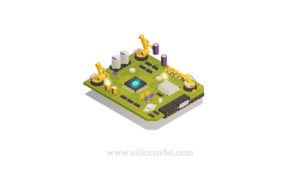Aluminum in Semiconductor
Aluminum plays a crucial role in semiconductor metallization systems due to its excellent conductivity, compatibility with semiconductor fabrication materials, and the ability to form low-resistance contacts through alloying with silicon. The deposition of aluminum typically involves evaporation, where aluminum evaporates from a crucible onto the wafer surfaces. To prevent oxidation, a high vacuum is maintained throughout the evaporation process.
What is Sintering?
Sintering, a brief heating process, is employed to form Ohmic contacts between aluminum and silicon. The alloying of aluminum and silicon at moderate temperatures creates a thin layer of aluminum-doped silicon beneath contact openings. This process facilitates Ohmic contact to P-type silicon because aluminum acts as an acceptor. The aluminum-silicon alloy forms a shallow, heavily doped P-type diffusion that bridges between the metal and the P-type silicon. Ohmic contact also occurs with heavily doped N-type silicon, where junctions form beneath the contacts, and thin depletion regions allow carriers to tunnel through, preventing rectification.
What is Contact Spiking?
However, sintering causes some aluminum to dissolve in the silicon, leading to silicon erosion and a potential failure mechanism called contact spiking. This issue can be mitigated by using an aluminum-silicon alloy. While theoretically saturated with silicon, in practice, careful control of sintering time and temperature is needed to minimize the separation of silicon content during alloy formation.

In high-density digital logic, increased current densities led to a failure mechanism known as electromigration. Carriers flowing through the metal collide with lattice atoms, causing metal atoms to move. At high current densities, this movement results in void formation between metal grains, leading to open-circuit failures. Alloying aluminum with a small percentage of copper, either as aluminum-copper-silicon or aluminum-copper alloys, significantly improves resistance to electromigration. This alloying enhances the reliability and longevity of metallization systems in modern semiconductor devices.